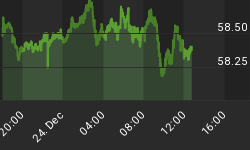The Gold Oil Ratio (GOR) had been in a bottoming stance since May (see Gold-Oil Ratio: Bottoming) and that bottoming stance - after a final capitulation plunge that never broke the bullish divergence - has now yielded the expected upturn in gold vs. crude.
Meanwhile, as the inflation/deflation debate rages on commodity bulls and oil bubble participants cannot unwind their positions fast enough. Last month we looked at Gold vs. the stock market (Dow & Gold: Very Different 'Bull' Markets) and today we will have a look at another gold ratio, the GOR.
The script is playing out roughly as anticipated with gold, a monetary asset beginning to outperform commodities with positive economic correlations, some of which represent cost inputs to gold miners' operations - a key to our battered but not broken gold stock investment stance - with the most high profile holdout, oil, now experiencing a swing from manic upside to manic depressive downside.
The first chart is a daily of nominal oil. I have green-lined visual lateral support, the first level of which is being approached by a falling wedge which has already retraced 38% of the mania from February.

The next daily chart is of the monetary 'commodity', which as expected has gotten caught up in the flight of the commodity bulls. While there has been some pain in gold, and especially gold stocks, a rational view of both gold and the major gold stock indexes begs the question 'is it really that bad?' The answer is yes if you are an 'all one commodity complex type of bull and you are being frightened into deflation hysterics. The answer is no if you realize that general commodities go up in economic booms created by inflation policy and tank in economic busts. It requires a lot of patience as many sell gold for the wrong reasons, but despite all the sound and fury, the bullish setup has not been broken. The chart is the chart and it is bullish. The preferred downside would be a hold of the neck line but recall the blog post showing potential for a pull back to the area of the 1980 highs as well, which would roughly correspond with a tap of the thicker blue breakout line below.

Not only has gold refused to break down in the face of the flight of the commodity bulls, but what do you suppose might happen to the yellow metal if oil should experience a sharp counter-bear trend rally, which is very possible if not likely? At a minimum gold would be expected to finish the cup pattern with a slightly higher high than the March top. I am bearish on oil beyond a near term bounce so I might expect another barfing of the commodity bulls to manifest itself in the formation of a consolidation handle on the golden cup. This is the process of weeding out those who hold gold for reasons like "high oil is causing inflation" or "the cost of living is so high". As the deflation impulse continues I expect the cost of living to come more in line with hopeful expectations. The problem will be that the economy will have come in by a country mile as well.
Here is the GOR daily chart showing the confirmed daily bottom in gold vs. oil. Next, we begin looking for weekly trend changes and we go back to monitoring the gold-silver ratio (which has been going sideways) as well.

Conclusion
Stock markets are enjoying a respite from the pain, as are the banks. Soon oil may follow. It says here that the true places to be have not changed through all the emotional short term drama; short term treasury instruments (or equivalent global government debt) for short term liquidity and gold for intrinsic value. A bonus would be a rebound in gold stocks due to the leverage that would fuel their bottom lines in the 'gold outperforms commodities' scenario. With oil having likely topped, the setup is in place to watch gold and cash begin to outperform all assets as the deflation impulse sends people running for safe liquidity. As stated many times, gold may decline in this atmosphere (although I am bullish on the nominal as well as asset-relative price, it is certainly possible), but it should outperform by a wide margin most other asset classes and unlike cash, it will retain enduring value far into the future. Jewelry is not what is important here. Nor is industrial usage or rising commodity prices. What is important, given the pressure on nations to burn their currencies, is investment value.
















